|
Chess has been used symbolically in almost every media and in every way
imaginable. In music, art, books, poems, chess has depicted the art of war and
the art of love, political conflicts and business conflicts, life in general and
life in a microcosm.
While chess has possibly been used in this
fashion since its infancy, the earliest extant work that employed chess
symbolically or allegorically was De Ludo Scachorum by Jacobus de
Cessolis.
Somewhere between 1275 and 1300 Frà
Jacopo de Cessole (Jacob
Cessolis, Jacques de Cessole, Jacobus de Cessolis, ), a Dominican Friar
from Lombardy, wrote a book called De Ludo Scachorum or De Moribus
Hominum et de Officiis Nobilium Super Ludo Scaccorum which is Latin for
simply About the Game of Chess or About the Customs of Men and the
Noble Actions Involving the Game of Chess.
This book is a series of sermons metaphorically
using chess to depict the relationships between a King and the various estates
of his Kingdom. The complicated metaphor was useless for those who didn't play
the game, so the author gave detailed instructions concerning the rules of chess
as it was played in the 13th century. For all its moralization, the main
interest of the text today is these instructions. It was during the 14th century
that this book was translated from the original Latin into Catalan, Dutch,
English, French, German and Italian.
It was translated into French and printed in
Toulouse in 1476. De Ludo Scachorum was first translated into French in
1347. In 1474, 2 years before it was printed in French, William Caxton
translated the text from a mixture of two Latin-to-French translations (one by
Jean Ferron and the other by Jean de
Vignay, entitled, Jeu des echecs moralisés) into English and printed
it under the title, The Game and
Playe of Chesse or The Game of Chess.
The Game of Chess was the second book
printed in the English language. The first book, also printed by Claxton was
The Recuyell of the Historyes of Troye, also translated from French (of
Raoul le Fèvre's
Recueil des histoires de Troye) and also in 1474. Caxton printed almost 100 books, and of these
20 were translations from French or Dutch into English.
The Game of Chess was
the first work dated by Caxton - March 31, 1474. It also has the second distinction of being the first book to be
reprinted! The second printing of the book in 1483 had an interesting sidebar:
It was printed in Westminster. The first edition was printed in Bruges where Caxton had been politically involved in the local merchant's association. He had
ingratiated himself with Margaret, the Duchess of York, the sister of King
Edward IV - in fact it was under her urging that he translated The Recuyell
of the Historyes of Troye to begin with. The book was dedicated to Edward's
son and Margaret's brother - George, Duke of
Clarence by his humble and unknown servant, William Caxton. Claxton set up a
press in Westminster in 1476 and, when in 1483 he reprinted the book, he praises
the book in the dedication for it's moral value and woodcut illustrations but
doesn't mention George who happened to have been beheaded for treason in 1478.
It seems possible, though not completely certain that Cessolis got his material
from an earlier compilation of sermons written in 1252 called The Innocent
Morality, supposedly witten by Johannes Gallensis (aka John of Wales). But
it's also been attributed to Pope Innocent III (where it gets it's title).
The Innocent Morality, ironically perhaps was printed in French in 1470 and
is the first time the term for Chess is seen in a printed book.
De Ludo Scachorum, while translated into
English and published in 1474, was definitely not a Renaissance work, but was
rather entrenched in Medieval philosophy. Cessolis was thought to have given a
series of sermons, using chess as his allegorical theme, designed to help define
the moral and ethical responsibilities of each of his listeners' positions in
life. Because of the popularity of these sermons, Cessolis (1288-1322) was
induced by his admirers to put them in a book form. At that time printing hadn't
yet been invented and copies were made by scribes who often signed and dated
their manuscripts. One of the earliest copies of De Ludo Scachorum was
scribed by Francis Gennay (probably of the Bologna area of Italy) in 1409.
Since the manuscript (and book) itself isn't
particularly long and since it contains an explanation of how to play chess as
well as a (mythical) history of the game, it seems more likely that Cessolis was
presenting an outline detailing how to use chess as a basis or theme for
sermons, explaining what the pieces and their placements represent.

An example of the text from a circa 1446 manuscript of De Ludo Scachorum
The top line reads:
Incipit prohemium libri compositi de ludo scachorum
a fratre de sexolis ordinis predicatorum
One of the most attractive features of this book
are the woodcut illustrations.
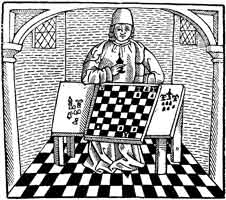
The Chess-Board
King
The kynge must be thus maad. For he must sitte in a chayer
clothed in purpure crowned on his heed in his ryght hand a ceptre and in the
lyfte hande an apple of gold
Queen
Thus ought the Quene be maad she
ought to be a fair lady sittynge in a chayer and crowned wyth a corone on her
heed and cladd wyth a cloth of gold & a mantyll aboue furrid wyth ermynes And
she shold sytte on the lyfte syde of the kinge for the amplections and
enbrasynge of her husbonde lyke as it is sayd in scripture in the canticles
Bishops - Judge (Alphyn)
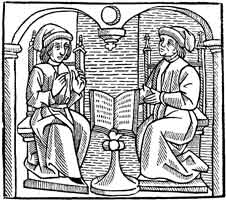 The
Alphyns ought to be made and formed in manere of Iuges syttynge in a chayer wyth
a book open to fore their eyen And that is be cause that some causes ben
crymynell And some ben cyuyle as aboute possessyons and other temporell thynges
and trespaces And therfore ought to be two Iuges in the royame one in the
black for the first cause And that other in whyte as for the seconde Theyr
office is for to counceyll the kynge And to make by his comandements good
lawes And to enforme alle the royame in good and vertuous maners And to Iuge and
gyue sentence well and truly after the caas is had And to counceyll well and
Iustely alle them that are counceyll of hem wyth oute hauynge of ony eye opene
to ony persone And to estudye diligently in suche wyse and to ordeygne alle that
that ought to be kept be obseruyd be faste and stable So that they be not founde
corrupt for yeft for favour ne for lignage ne for enuye variable And as
touchynge the first poynt Seneque sayth in the book of benefetes that the poure The
Alphyns ought to be made and formed in manere of Iuges syttynge in a chayer wyth
a book open to fore their eyen And that is be cause that some causes ben
crymynell And some ben cyuyle as aboute possessyons and other temporell thynges
and trespaces And therfore ought to be two Iuges in the royame one in the
black for the first cause And that other in whyte as for the seconde Theyr
office is for to counceyll the kynge And to make by his comandements good
lawes And to enforme alle the royame in good and vertuous maners And to Iuge and
gyue sentence well and truly after the caas is had And to counceyll well and
Iustely alle them that are counceyll of hem wyth oute hauynge of ony eye opene
to ony persone And to estudye diligently in suche wyse and to ordeygne alle that
that ought to be kept be obseruyd be faste and stable So that they be not founde
corrupt for yeft for favour ne for lignage ne for enuye variable And as
touchynge the first poynt Seneque sayth in the book of benefetes that the poure
Knight
 The
knyght ought to be made alle armed upon an hors in suche wyse that he haue an
helme on his heed and a spere in his ryght hande and coueryd wyth his
sheld a swerde and a mace on his lyft syde Cladd wyth an hawberk and plates to
fore his breste legge harnoys on his legges Spores on his heelis on his handes
his gauntelettes his hors well broken and taught and apte to bataylle and
couerid with his armes whan the knyghtes ben maad they ben bayned or bathed that
is the signe that they shold lede a newe lyf and newe maners also they wake alle
the nyght in prayers and orysons vnto god that he wylle gyue hem grace that they
may gete that thynge that they may not gete by nature The kynge or prynce
gyrdeth a boute them a swerde in signe that they shold abyde and kepe hym of
whom they take theyr dispenses and dignyte. Also a knyght ought to be wise,
liberall, trewe, stronge and full of mercy and pite and kepar of the peple
and of the lawe The
knyght ought to be made alle armed upon an hors in suche wyse that he haue an
helme on his heed and a spere in his ryght hande and coueryd wyth his
sheld a swerde and a mace on his lyft syde Cladd wyth an hawberk and plates to
fore his breste legge harnoys on his legges Spores on his heelis on his handes
his gauntelettes his hors well broken and taught and apte to bataylle and
couerid with his armes whan the knyghtes ben maad they ben bayned or bathed that
is the signe that they shold lede a newe lyf and newe maners also they wake alle
the nyght in prayers and orysons vnto god that he wylle gyue hem grace that they
may gete that thynge that they may not gete by nature The kynge or prynce
gyrdeth a boute them a swerde in signe that they shold abyde and kepe hym of
whom they take theyr dispenses and dignyte. Also a knyght ought to be wise,
liberall, trewe, stronge and full of mercy and pite and kepar of the peple
and of the lawe
Rook - governors
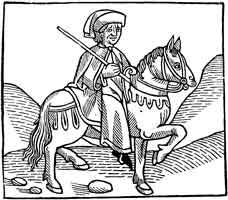 The
rooks whiche ben vicaires and legats of the kynge ought to be made lyke a knyght
vpon an hors and a mantell and hood furryd with meneuyer holdynge a staf in his
hande & for as moche as a kyng may not be in alle places of his royame Therfore
the auctorite of hym is gyuen to the rooks whiche represent the kynge And for as
moche as a royame is grete and large and that rebellion or nouelletes might
sourdre and aryse in oon partye or other therfore ther ben two rooks one on the
right side and that other on the lifte side They ought to haue in hem. pyte.
Iuftice. humylite. wilfull The
rooks whiche ben vicaires and legats of the kynge ought to be made lyke a knyght
vpon an hors and a mantell and hood furryd with meneuyer holdynge a staf in his
hande & for as moche as a kyng may not be in alle places of his royame Therfore
the auctorite of hym is gyuen to the rooks whiche represent the kynge And for as
moche as a royame is grete and large and that rebellion or nouelletes might
sourdre and aryse in oon partye or other therfore ther ben two rooks one on the
right side and that other on the lifte side They ought to haue in hem. pyte.
Iuftice. humylite. wilfull
pouerte. and liberalite Fyrst Iustice for hit is most fayr of the vertues For it
happeth oftetyme that the ministris by theyr pryde and orgueyll subuerte Iuftice
and do no ryght
Pawns
Farmer
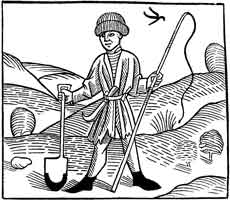 Than
I shall begynne fyrst at the fyrst pawne that is in the playe of the chesse And
signefieth a man of the comyn peple on fote For they be all named pietous that
is as moche to saye as footemen And than we wyll begynne at the pawne whiche
standeth to fore the rooke on the right side of the kinge for as moche as this
pawne apperteyneth to serue the vicaire or lieutenant of the kynge and other
officers vnder hym of necessaryes of vitayll And this maner a peple is figured
and ought to be maad in the forme & shappe of a man holdynge in his ryght hande
a spade or shouell And a rodde in the lifte hand The spade or shouell is for to
delue & labour therwith the erthe And the rodde is for to dryue & conduyte wyth
all the bestes vnto her pasture also he ought to haue on his gyrdell a crokyd
hachet for to cutte of the supfluytees of the vignes & trees Than
I shall begynne fyrst at the fyrst pawne that is in the playe of the chesse And
signefieth a man of the comyn peple on fote For they be all named pietous that
is as moche to saye as footemen And than we wyll begynne at the pawne whiche
standeth to fore the rooke on the right side of the kinge for as moche as this
pawne apperteyneth to serue the vicaire or lieutenant of the kynge and other
officers vnder hym of necessaryes of vitayll And this maner a peple is figured
and ought to be maad in the forme & shappe of a man holdynge in his ryght hande
a spade or shouell And a rodde in the lifte hand The spade or shouell is for to
delue & labour therwith the erthe And the rodde is for to dryue & conduyte wyth
all the bestes vnto her pasture also he ought to haue on his gyrdell a crokyd
hachet for to cutte of the supfluytees of the vignes & trees
Smith
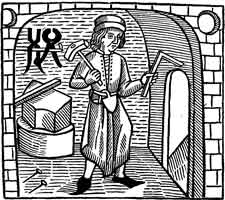
The seconde pawne y't standeth to fore the knyght on the right side of the kynge
hath the forme and figure of a man as a smyth and that is reson For hit
apperteyneth to y'e knyghtes to haue bridellys sadellys spores and many other
thynges made by the handes of smythes and ought to holde an hamer in his right
hande. And in his lyfte hand a dolabre and he ought to haue on his gyrdell a
trowell For by this is signefied all maner of werkemen as goldsmithes.
marchallis, smithes of all forges forgers and makers of monoye & all maner of
smythes ben signefyed by the hamer The carpenters ben signefyed by the dolabre
or squyer And by the trowell we vnderstande all masons & keruars of stones
tylers and alle them that make howses castels & tours
Clothmaker
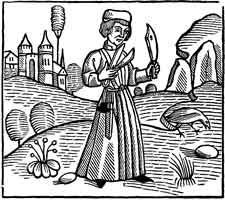 The thirde
pawne whiche is sette to fore the Alphyn on the right side ought to be figured
as a clerk And hit is reson that he shold so be For as moche as amonge y'e comon
peple of whom we speke in thys book they plete the differencis contencions and
causes otherwhile the whiche behoueth the The thirde
pawne whiche is sette to fore the Alphyn on the right side ought to be figured
as a clerk And hit is reson that he shold so be For as moche as amonge y'e comon
peple of whom we speke in thys book they plete the differencis contencions and
causes otherwhile the whiche behoueth the
Alphins to gyue sentence and Iuge as Iuges And hit is reson that the Alphin or
Iuge haue his notarye by whom y'e processe may be wreton And this pawne ought to
be made and figured in this mamere he muste be made like a man that holdeth in
his right hand a pair of sheres or forcetis and in the lifte hand a grete knyf
and on his gurdell a penuer and an ynkhorn and on his eere a penne to wryte wyth
And that ben the Instrumentis & the offices that ben made and put in writynge
autentyque and ought to haue passed to fore the Iuges as libelles writtes
condempnacions and sentences And that is signefied by the scriptoire and the
penne and on that other part hit appertayneth to them to cutte cloth. shere.
dighte. and dye and that is signefied by the forcettis or sheres and the other
ought to shaue berdes and kembe the heeris And the other ben coupers. coryers.
tawiers. skynners. bouchers and cordwanners and these ben signefyed by the knyf
that he holdeth in his hand and some of thise forsayd crafty men ben named
drapers or clothmakers for so moche as they werke wyth wolle.
Money Changer
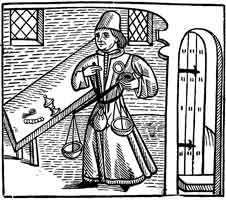
The fourth pawn is sette to for the kynge
And is formed in the fourme of a man holding in his ryght hand a balance And the
weyght in the lifte hand And to fore hym a table And at his gurdell a purse
fulle of monoye redy for to gyue to them that requyre hit And by this peple ben
signefied the marchans of cloth lynnen and wollen & of all other marchandises
And by the table that is to for hym is signefied y'e changeurs And they that
lene money And they that bye & selle by the weyght ben signefyed by the balances
and weight
Doctor
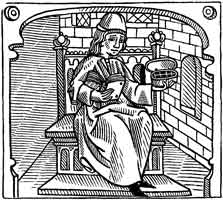
The pawn that is sette to fore the quene signefyeth the phisicyen spicer and
Apotyquaire and is formed in the figure of a man And he is sette in a chayer as
a maystre and holdeth in his right hand a book And an ample or a boxe wyth
oynementis in his lyft hand And at his gurdell his Instrumentis of yron and of
siluer for to make Incysions and to serche woundes and hurtes and to cutte
apostumes And by thyse thynges ben knowen the cyrurgyens By the book ben
vnderstanden the phisicyens and alle gramaryens. logicyens maistres of lawe. of
Geometrye. Arismetryque. musique and of
astronomye And by the ampole ben signefyed the makers of pigmentaries spicers
and apotiquayres and they that make confections and confytes and medecynes made
wyth precyous spyces
Innkeeper
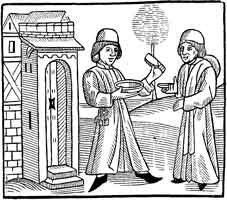 The sixthe
pawn whiche standeth to fore the Alphyn on the lyfte syde is made in thys forme.
For hit is a man that hath the right hande stracched oute as for to calle men
And holdeth in his lyfte hande a loof of breed and a cuppe of wyn And on his
gurdell hangynge a boudell of keyes And this resembleth the Tauerners. hostelers.
and sellars of vitaylle. And thise ought proprely to be sette to fore the Alphyn
as to fore a Iuge For ther sourdeth ofte tymes amonge hem contencion noyse and
stryf whiche behoueth to be determyned and trayted by the alphyn whiche is Iuge
of the kynge And hit apperteyneth to them for to seke and enquyre for good wyns
and good vitayll for to gyue and selle to the byers And to them that they
herberowe And hit apperteyneth to them well to kepe their herberowes and Innes
and alle tho thyngis that they brynge in to their loggynge and for to putte hyt
in seure and sauf warde and kepynge And the firste of them Is signefyed by the
lyfte hande in whiche he bereth brede and wyn and the seconde is signefied by
the right hande whiche Is stracched oute to calle men And the thirde is
representid by the keyes hangynge on y'e gurdell And thyse maner of peple ought
teschewethe synne of glotonye The sixthe
pawn whiche standeth to fore the Alphyn on the lyfte syde is made in thys forme.
For hit is a man that hath the right hande stracched oute as for to calle men
And holdeth in his lyfte hande a loof of breed and a cuppe of wyn And on his
gurdell hangynge a boudell of keyes And this resembleth the Tauerners. hostelers.
and sellars of vitaylle. And thise ought proprely to be sette to fore the Alphyn
as to fore a Iuge For ther sourdeth ofte tymes amonge hem contencion noyse and
stryf whiche behoueth to be determyned and trayted by the alphyn whiche is Iuge
of the kynge And hit apperteyneth to them for to seke and enquyre for good wyns
and good vitayll for to gyue and selle to the byers And to them that they
herberowe And hit apperteyneth to them well to kepe their herberowes and Innes
and alle tho thyngis that they brynge in to their loggynge and for to putte hyt
in seure and sauf warde and kepynge And the firste of them Is signefyed by the
lyfte hande in whiche he bereth brede and wyn and the seconde is signefied by
the right hande whiche Is stracched oute to calle men And the thirde is
representid by the keyes hangynge on y'e gurdell And thyse maner of peple ought
teschewethe synne of glotonye
Town Gatekeeper
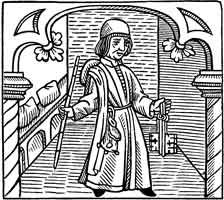
The gardes and kepars of of cytees ben
signefied by the vii pawn whiche stondeth in the lyfte side to fore the knyght
And is formed in the semblance of a man holdynge in his right hande grete keyes
And in his lifte hande a potte & an elle for to mesure with And ought to haue on
hys gurdell a purse open/ And by the keyes ben signefyed the kepars of the
cytees and townes and comyn offices And by the potte and elle ben signefyed them
that haue the charge to weye and mete & mesure truly And by the purse ben
signefyed them that reseyue the costumes. tolles. scawage. peages and duetes of
the cytees & townes
Messenger
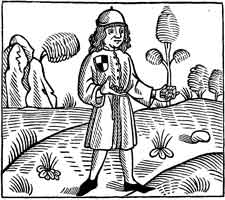 The rybaulders,
players of dyse and of messagers and corrours ought to be sette to fore the rook
For hit apperteyneth to the rook whiche is vicayre & lieutenant of the kynge to
haue men couenable for to renne here and there for tenquyre & espie the place
and cytees that myght be contrarye to the kynge And thys pawn that representeth
thys peple ought to be formed in this maner he must haue the forme of a man that
hath longe heeris and black and holdeth in his ryght hand a lityll monoye And in
his lyfte hande thre Dyse And aboute hym a corde in stede of a gyrdell and ought
to haue a boxe full o lettres And by the first whiche is money is vnderstand
they that be fole large & wastours of theyr goodes And by the seconde whiche is
the dyse Ben represented the players at dyse Rybauldes and butters And by the
thyrde whiche is the boxe full of lettres ben representid the messagers. The rybaulders,
players of dyse and of messagers and corrours ought to be sette to fore the rook
For hit apperteyneth to the rook whiche is vicayre & lieutenant of the kynge to
haue men couenable for to renne here and there for tenquyre & espie the place
and cytees that myght be contrarye to the kynge And thys pawn that representeth
thys peple ought to be formed in this maner he must haue the forme of a man that
hath longe heeris and black and holdeth in his ryght hand a lityll monoye And in
his lyfte hande thre Dyse And aboute hym a corde in stede of a gyrdell and ought
to haue a boxe full o lettres And by the first whiche is money is vnderstand
they that be fole large & wastours of theyr goodes And by the seconde whiche is
the dyse Ben represented the players at dyse Rybauldes and butters And by the
thyrde whiche is the boxe full of lettres ben representid the messagers. | 
